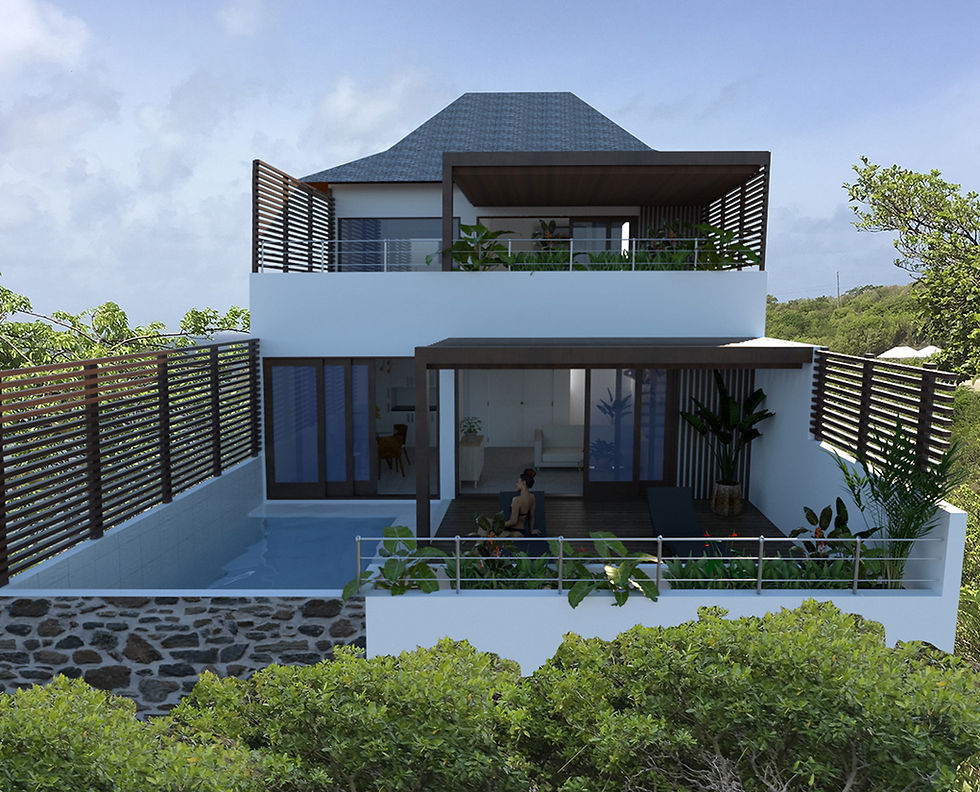Architectural Styles
- Contemporary Caribbean
- Feb 13
- 2 min read
Updated: Mar 28
Let's talk architectural styles. Contemporary Caribbean architecture is a fusion of traditional Caribbean design elements with modern innovations, focusing on sustainability, climate responsiveness, and cultural identity. It embraces open, airy spaces, natural materials, and a seamless connection between indoor and outdoor living. Hallmarks of this style include wide verandas, louvered windows, pitched roofs, and elevated structures to facilitate ventilation and protection from tropical weather. The degree to which a building resides in one style or the other is a reflection of design elements selected.
A lot of what you see outside is not about the floorplan. It is more about the articulation or expression of the floorplan, how we choose to articulate elements. Lets look at 2 examples below.

or

Transitional Style: This Villa is designed with a Dutch roof (a hint to the traditional) and wood elements that help to create a feeling of warmth. This style is inbetween traditional caribbean style and a modern style. It is transitional.

Modern Style: This villa has the exact same flooplan as the one above, but the articulation on the outside is different. It feature very clean modern lines. Maintaining the wood accentes on the window and pergola help to soften the concrete structure. The concrete articulation creates deep eaves in the veranda. For some this is cave like. For others it offers the privacy they are seeking. It is all a matter of choice.

Look at the impression the two different articulations create when implemented as multiples.
Whether it is a traditional creole style, a transitional style or an ultra modern style, each design sensibility has its own impact on an individual and the environment around it. We have to carefully place new architecture into the build environment. For example juxtapositioning an ultra modern style amongst traditional colonial or creole styles must be done carefully and with a soft hand. You want the fabric of the environment to feel knitted together, not have a fabric with one strange piece sticking out. It looks like an accident. What is needed is for the the architecture to feel iconic and the existing environment to act as a canvas to showcase it.
Another contemporary articulation in warm topical environments is a Troical Modern style.
Tropical Modern architecture is an evolution of modernist principles adapted to warm, humid climates. It integrates passive cooling techniques, large overhangs for shade, natural ventilation strategies, and the use of materials such as wood, stone, and concrete. Architects like Geoffrey Bawa pioneered this approach, blending minimalism with lush greenery and open-plan spaces.
In the Caribbean, these styles merge to create homes and buildings that balance aesthetics with function, incorporating:
Open floor plans to encourage airflow and natural cooling.
Sustainable materials like bamboo, reclaimed wood, and local stone.
Shading devices such as pergolas, deep eaves, and trellises.
Indoor-outdoor living with terraces, courtyards, and infinity pools.
Eco-friendly solutions like rainwater harvesting, solar panels, and green roofs.
This architectural approach celebrates the region’s tropical beauty while embracing modern comforts, ensuring resilience against the climate and enhancing a relaxed, island-inspired lifestyle.



Comments